The Best Minimalist Running Shoes
This article originally appeared on Outside
Minimalist shoes are born from the assumption that the best, most natural running is done barefoot. Your feet should be free to be feet: complex constructions of arches, cables, and levers that react and adapt instantly to cushion, stabilize and propel. Given that most people today didn't grow up going bare in all conditions, and thus didn’t develop the calloused soles necessary to tread safely and comfortably on all but the softest terrains, minimalists concede that some sort of shoes are a necessary evil. But, to maintain natural foot strength, proprioception, muscle activation, posture, and gait patterns, they believe shoes should stay as close to bare as possible.
What makes a shoe minimalist is a matter of debate, but in 2015, 42 experts from 11 countries agreed on a formal definition: “Footwear providing minimal interference with the natural movement of the foot due to its high flexibility, low heel to toe drop, weight and stack height, and the absence of motion control and stability devices." That definition provided parameters to determine how minimal any particular pair is, but left open to interpretation the exact line where a shoe becomes too high, too stiff, or too controlling to be considered minimalist. If you choose to go more minimal, which many experts argue is beneficial for your running stride, balance, and strength, it is up to you to decide which characteristics are most important and how low you want to go.
RELATED: Long After the Minimalist Revolution, Chris McDougall Returns with “Born to Run 2”
Maximizing Your Minimalist Experience
Put on a pair of minimalist shoes and you instantly feel light, nimble, and alive. Head out the door and you dance along, feeling a new, intimate, interactive connection with the earth beneath your feet--until you tire and start clomping along with no cushioning underfoot and return home to find your calves and achilles screaming. Most runners need to transition to minimal footwear very gradually, building up miles in them as slowly as they first added running miles when a beginner, or using them only occasionally as training devices.
Whether or not you adopt minimal footwear all the time, using them sparingly is worthwhile, to improve your posture, stride, and foot strength--particularly if combined with exercises to enhance hip flexibility and strengthen your posterior chain. And nearly everybody can use minimal shoes for walking and daily wear, which experts agree is as, or more, valuable for improving your biomechanics than running in them.
Meet Our Tester
Jonathan Beverly, senior running editor
I fell in love with running my freshman year in high school in 1977, and quickly became fascinated with finding the perfect pair of running shoes. That quest got a boost when I became editor of Running Times in 2000 and started receiving every new model as they were released. I embraced the minimalist movement in the early 2010's, running thousands of miles-- including road and trail races--in barely-there shoes which reconnected me with my body and the earth, rejuvenating my running. But after suffering a metatarsal stress fracture and seeing others get injured in minimalist footwear, I dug into the contradictory studies on shoes and running form and talked to dozens of experts--from scientists to medical professionals to coaches--trying to determine common ground. That research turned into my book, Your Best Stride, which explores how to counteract the forces of a modern sedentary lifestyle and restore natural posture and movement so you can run more effectively (in any footwear). Today, I wear every type of running shoe as a tester, but retain a preference for more minimal models, which I wear exclusively when not running. During this testing, however, I found that my adaptation to running in ultra-thin shoes had waned and my experience in them seemed typical for runners who have some experience with light, low models but are mostly accustomed to today's high, soft shoes.
For this review, I ran in each model several times over two months, trying each on different terrains and at a variety of paces, as well as rotating them as my walking and casual shoes throughout the test period. Here are my picks for the best minimalist shoes for running today, ranging from nearly-bare to lightly-cushioned models that are decidedly more minimal than today's mainstream, highly-cushioned, rigid, rockered rides.
Minimalist Shoes Reviewed
Vivobarefoot
Primus Lite III $160
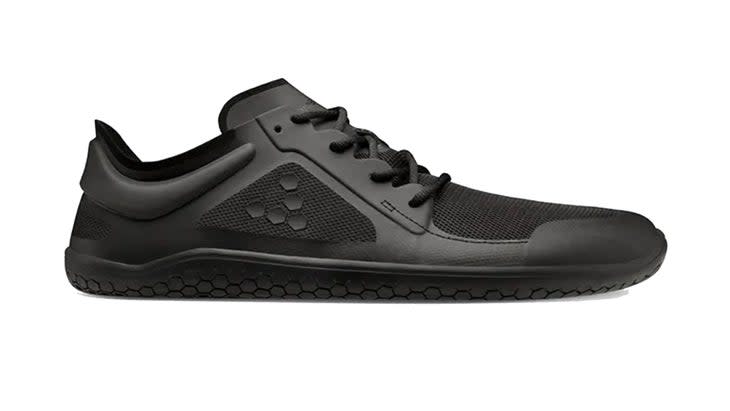
Weight: 9.3 oz (M)/ 5.6 oz (W)
Sole Thickness: 4 mm (+ 2 mm insole if desired)
With the thinnest sole of shoes tested, the Primus Lite III provided unparalleled ground feel. I initially wore these as casual shoes and found my feet and stance waking up enough to want to use them on increasingly longer and more frequent runs. The puncture-resistant sole flexes easily in all directions, with a light honeycomb pattern providing grip on smooth surfaces. The upper is both rugged and breezy, with substantial toe bumpers and a reinforced saddle that holds from instep to ball overlaying a thin, flexible mesh. The collar snugs the heel with light padding, but the heel cup is pliable and, like the rest of the shoe, doesn't try to control.
Primus Trail Knit FG $180
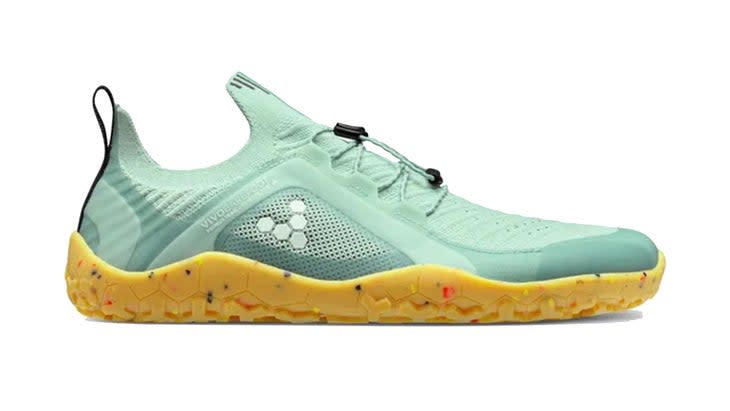
Weight: 8.8 oz (M)/ 5.4 oz (W)
Sole Thickness: 6.5 mm (+ 2 mm insole if desired)
I pulled this sock-like shoe on, cinched the speed lace, and felt like I had grown a tough, toothy tread on the bottom of my soles. My feet felt alive as I danced through three miles of gravel, sand, rock, and tufted grasses--and afterward felt muscles in my feet and calves that hadn't been recruited for some time. The firm sole, which wraps up around the sides, has thick, grippy, and protective 4mm-deep lugs, but flexes with ease, enabling superior ground feel and terrain-adaptable landings and push-offs. Up top, the knit mesh is comfy and breathable with a sturdy wrap over the midfoot. The weight of the sole and upper overlays make this shoe feel as suitable for hiking as for running; I mixed up the two on subsequent outings and the shoes proved rugged enough to protect over whatever terrain I tackled.
Vibram
V-Run Retro $135
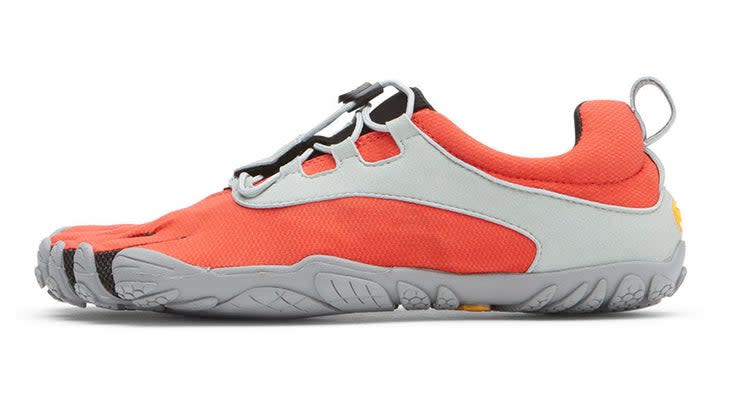
Weight: 5.7 oz (M)/ 4.6 oz (W)
Sole Thickness: 6 mm (includes non-removable insole)
Running in the V-Run Classic is a familiar sensation for those who lived through the minimalist movement, delivering a feeling of running barefoot as a child: free, alive, and in touch with the earth. The design delivers unsurpassed toe splay, enforced by the separate toe pockets (similar to Correct Toes spacers, which I recommend wearing with any minimalist shoes). The thin, unpadded sole flexes with every movement as if it were a tough layer of skin, and the soft nylon mesh upper breathes and stays out of the way. I put in many miles in similar Five Fingers in the early 2010s, on terrain ranging from asphalt streets to gravel backroads to jungle mud, and always felt like my body was waking up and I was present and paying attention like seldom before. I also, however, got injured going too long, too hard, too soon in them. This time I used them for shorter runs a couple of times per week, and loved the reconnection with the earth, always ending up doing some fast, nimble pickups or hill sprints.
V-Run $140
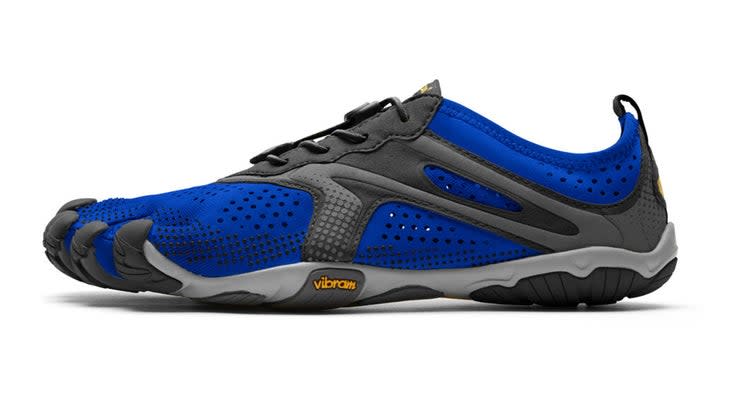
Weight: 4.8 oz (M) / 3.9 oz (W)
Sole Thickness: 8.5 mm (includes non-removable insole)
The V-Run is lighter than the Retro, while more supportive. The weight reduction comes mostly from the thin, perforated upper that is more breathable but less soft than the Retro knit. Underfoot, the sole is thicker, stiffer, and more sculpted, providing some support as well as padding from a thin EVA midsole. I found it felt protective and fast, but also less comfortable than the Retro, and the ride less connected and proprioceptive.
V-Trail 2.0 $135
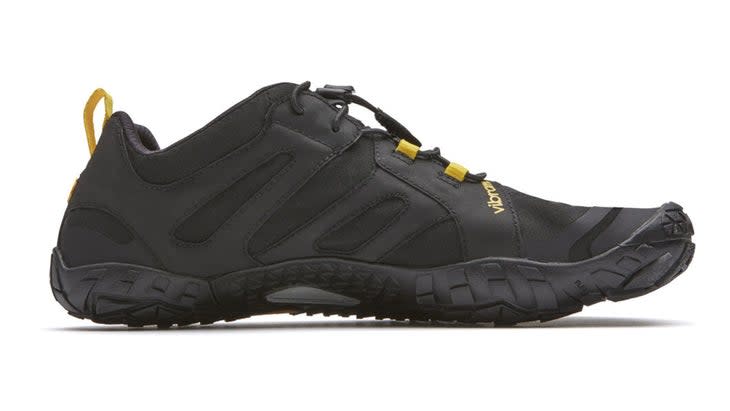
Weight: 6.4 oz (M)/5.0 oz (W)
Sole Thickness: 5.7 mm (includes non-removable insole)
The V-Trail made me feel bear-like, with big, clawed toes digging into the terrain. The luggy sole is thin and flexible underfoot, even with a protective mesh rock plate. The upper, however, is thick, water resistant and reinforced around the toes, making it rugged and durable, but, I found, quite stiff and abrasive. I found the wrap-around rubber sole also bumped the end of my toes, so recommend wearing toe socks with these.
Xero Shoes
Forza $130
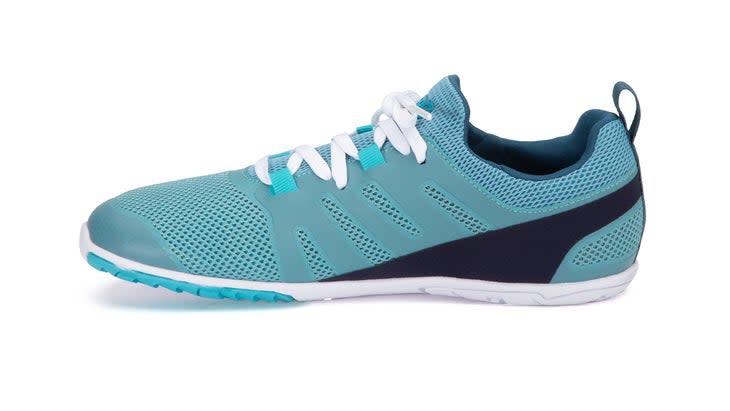
Weight: 7.2 oz (M) / 6.4 oz (W)
Sole Thickness: 6 mm (+3.5 mm insole if desired)
It took a bit of effort to get into the booty-type upper, but once in, this shoe disappeared like a second skin. Strategic straps that connect the lacing to the sole, combined with a clever lacing pattern, let me lock down each section of the airy upper to my desired tightness, while underfoot the thin, durable sole (it’s guaranteed for 5,000 miles) formed to my feet and flexed invisibly in every direction. Walking or running, my feet felt engaged, alive and free, with just enough protection to throw caution aside and fly.
Mesa Trail II $120
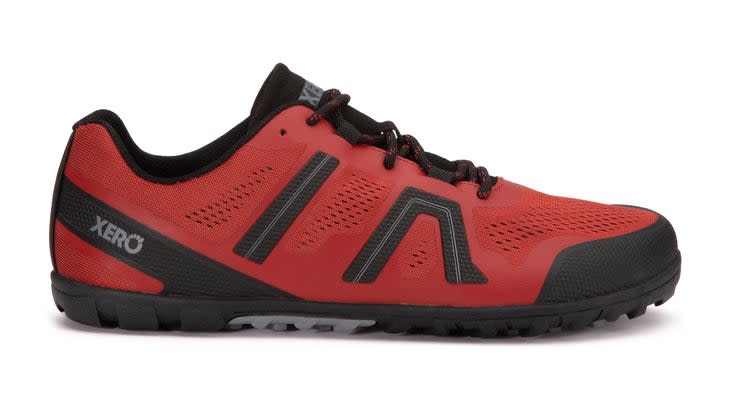
Weight: 8.2 oz (M)/6.4 oz (W)
Sole Thickness: 8 mm (+3.5 mm insole if desired)
The fit made these Uber-comfortable trail slippers stand out from the pack. The laces tie into straps (inspired by Huarache sandals) that wrap around the instep and just behind the ball at the midfoot, creating a confident lock-down without interfering with the action of the arch or constraining forefoot splay and flex. Underfoot, a three-millimeter layer of foam over the rugged, knobby outsole took the sting out of ground contact and protected from pokey things on the trail while still letting me feel and interact with the surface. They're so comfortable and good-looking I wanted to wear them every day, all day--from dancing across hills to walking city streets.
Merrell
Trail Glove 6 $110
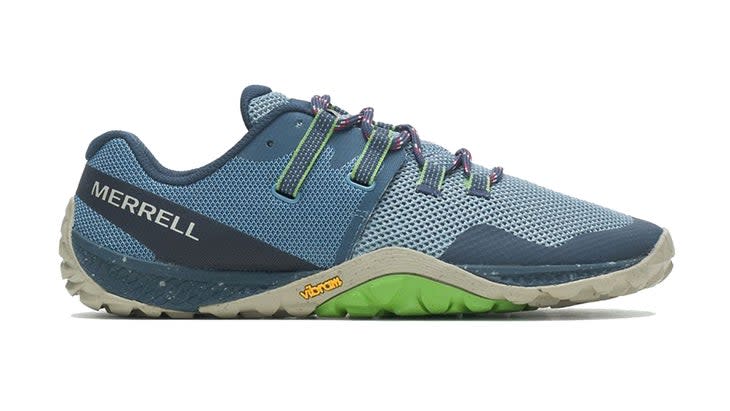
Weight: 7.5 oz
Sole Thickness: 11.5 mm (includes non-removable insole)
The first thing I noticed when I put on the Trail Glove 6 was the underfoot support. The sole is sculpted up under the arch and the upper extends that support with a stiff, semi-circular overlay. Meanwhile, 8.5 mm of midsole foam delivers moderate cushioning. While still zero-drop and close to the ground, my feet didn't have to work as much in these, making it easy to put in more trail miles in them right off the bat--but producing less of a training effect. I appreciated the protection from three millimeter-deep Vibram-rubber lugs and the forefoot rock plate on more rugged trails, and the fit lives up to its glove-like name with a snug inner booty wrapped by adjustable straps that tie into the laces.
(Note: Merrell also has a road version called the Vapor Glove that has traditionally been lighter, thinner, and less supportive than the Trail Glove. They are releasing a new version in January 2023 and do not yet have samples available for testing.)
Topo Athletic
ST-4 $110

Weight: 7.3 oz (M) / 6.1 oz (W)
Sole Thickness: 16 mm (includes removable insole)
Topo's ST-4 has become my do-anything shoe, from running to strength workouts, pickup basketball games, or just walking around town. I love the soft, snug, and uncontrolling heel, ample forefoot, unstructured upper, and firm, responsive sole that takes the edge off ground contact without getting in the way of proprioception and stable, powerful push-offs. Even for someone not well-adapted to minimal footwear, the ST-4 disappears and lets me move nimbly and naturally without thinking about my feet or ending the day beat up.
Altra
Escalante 3 $140
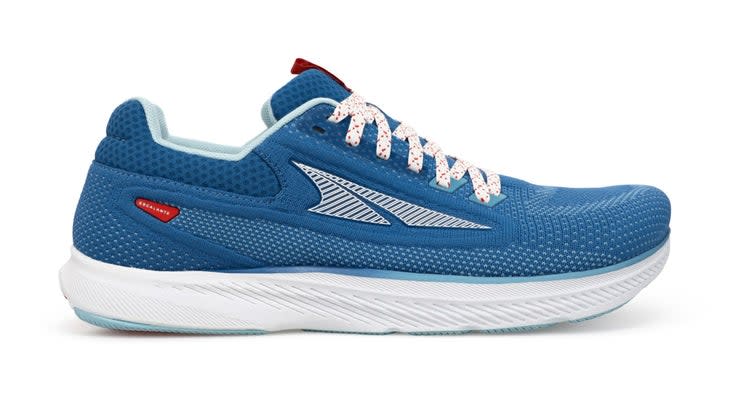
Weight: 9.3 oz (M) / 7.7 oz (W)
Sole Thickness: 24 mm (includes removable insole)
The Escalante is foot-shaped and zero-drop, but doesn't count as a true minimalist shoe to purists as it has 24 millimeters of cushy, bouncy foam reducing flexibility, removing ground feel, and blocking some foot activation. Compared to most of today's shoes, however, I found the moderately-thin sole provided plenty of proprioception, enhanced by Altra's proprietary AltraEGO foam that firms up quickly on compression with a lively bounce-back. The lightly structured, engineered knit upper coddled my feet without controlling their movement. I found myself running tall and striding quickly in these, and was able to go as long as I wanted without feeling post-run foot and calf soreness.
Superior 5 $130
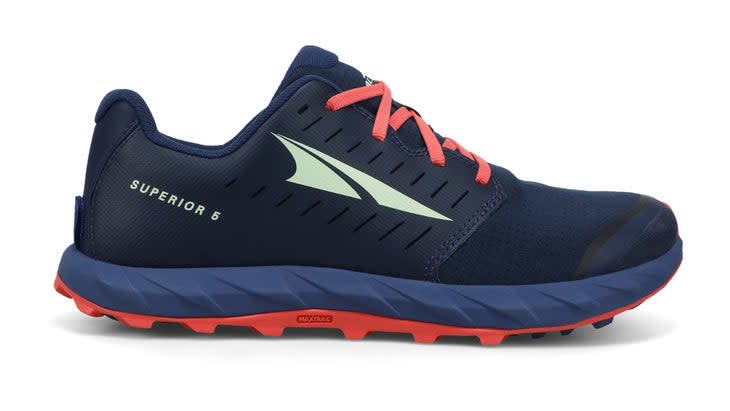
Weight: 8.8 oz (M)/7.5 oz (W)
Sole Thickness: 21 mm (includes removable insole)
Full disclosure, I've been an unapologetic fan of the Superior since it came out--the light, balanced ride makes me feel like a wild animal padding lightly over prairie and mountain trails. The sole is thinner, more flexible, and slightly firmer than the Escalante's, with a fast-rebounding cushion providing proprioception and keeping ground contact quick. The midfoot "burrito wrap" is flexible and secure and the forefoot fit is generously wide with plenty of room for splay, making for stable steps on any terrain. The optional flexible rock plate that inserts under the sock liner adds a protective layer and seemed to make the ride even more nimble. I have to maintain good posture and lightly in these or they start to feel too sparse underfoot over tricky terrain, but as long as I don't go too far I can run in them daily. (Note: v 5 runs short, so size up a half step).
For other minimalist options, look into:
And for an even more minimalist feel, consider sandals from:
For exclusive access to all of our fitness, gear, adventure, and travel stories, plus discounts on trips, events, and gear, sign up for Outside+ today.

